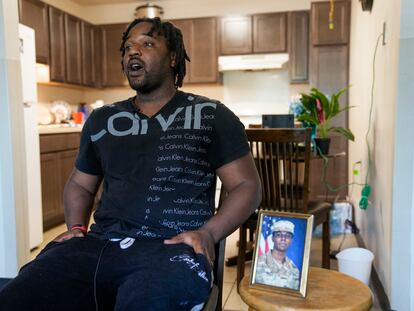While North Korea fires cruise missiles, it stays mum on US soldier who crossed into the country
South Korea’s Joint Chiefs of Staff says Saturday’s launches were detected beginning around 4 a.m.

North Korea fired several cruise missiles toward its western sea Saturday, South Korea’s military said, marking the second launch event this week, apparently in protest of the docking of a nuclear-armed U.S. submarine in South Korea.
While adding to its barrage of missile launches in recent months, North Korea remained publicly silent for a fifth day on the fate of an American soldier who bolted into the North across the heavily armed Korean border this week.
South Korea’s Joint Chiefs of Staff said the launches were detected beginning around 4 a.m. but did not immediately report how many missiles were fired or how far they flew. It said the United States and South Korean militaries were closely analyzing the launches.
North Korea in recent years has been testing newly developed cruise missiles it describes as “strategic,” implying an intent to arm them with nuclear weapons. Experts say the main mission of those weapons would include striking naval assets and ports. Designed to fly like small airplanes and travel along landscape that would make them harder to detect by radar, cruise missiles are among a growing collection of North Korean weapons aimed at overwhelming missile defenses in the South.
On Wednesday, North Korea fired two short-range ballistic missiles from an area near its capital, Pyongyang. They flew about 550 kilometers (340 miles) before landing in waters east of the Korean Peninsula.
The flight distance of those missiles roughly matched the distance between Pyongyang and the South Korean port city of Busan, where the USS Kentucky on Tuesday made the first visit by a U.S. nuclear-armed submarine to South Korea since the 1980s.
Also Tuesday, American soldier Pvt. Travis King sprinted across the border into North Korea while on a tour of an inter-Korean truce village.
North Korea’s state media has yet to comment on King and the country has not responded to U.S. requests to clarify where he is being kept and what his condition is. U.S. officials have expressed concern about King’s well-being, considering North Korea’s previous rough treatment of some American detainees. It could be weeks, or even months, before North Korea releases meaningful information about King, analysts say, as the country could drag out his detention to maximize leverage and add urgency to U.S. efforts to secure his release.
Some experts say the North may try to use King for propaganda or as a bargaining chip to coax political and security concessions from Washington, possibly tying his release with the United States cutting back its military activities with South Korea.
“With so many moving pieces, it’s important not to attribute causation to mere correlation of events. But North Korea’s missile provocations do not foreshadow an easy negotiation to secure Travis King’s release,” said Leif-Eric Easley, a professor at South Korea’s Ewha University. “Unauthorized border crossings endanger personnel, risk a political and even military incident, and can be exploited by North Korean hostage diplomacy.”
The United States and South Korea have been expanding their combined military exercises and have agreed to increase the regional deployment of U.S. strategic assets like bombers, aircraft carriers and submarines in a show of force against North Korea, which has test-fired around 100 missiles since the start of 2022.
The allies also kicked off new rounds of nuclear contingency planning meetings that are partially aimed at easing fears among the South Korean public about the North’s growing nuclear threat and suppressing voices within the country that it should pursue its own deterrent.
North Korea’s defense minister issued a veiled threat Thursday suggesting the docking of the Kentucky in South Korea could be grounds for a nuclear attack by the North. North Korea has used such rhetoric before, but the comments underscored how much relations are strained now.
South Korea’s Defense Ministry on Friday described the deployment of the Kentucky and the nuclear contingency planning meetings between Washington and Seoul as “defensive response measures” to counter the North Korean threat. The ministry said in a statement it “strongly warns” that any nuclear attack by the North on the allies would face an “immediate, overwhelming and decisive response … that would bring an end to the North Korean regime.”
Sign up for our weekly newsletter to get more English-language news coverage from EL PAÍS USA Edition
Tu suscripción se está usando en otro dispositivo
¿Quieres añadir otro usuario a tu suscripción?
Si continúas leyendo en este dispositivo, no se podrá leer en el otro.
FlechaTu suscripción se está usando en otro dispositivo y solo puedes acceder a EL PAÍS desde un dispositivo a la vez.
Si quieres compartir tu cuenta, cambia tu suscripción a la modalidad Premium, así podrás añadir otro usuario. Cada uno accederá con su propia cuenta de email, lo que os permitirá personalizar vuestra experiencia en EL PAÍS.
¿Tienes una suscripción de empresa? Accede aquí para contratar más cuentas.
En el caso de no saber quién está usando tu cuenta, te recomendamos cambiar tu contraseña aquí.
Si decides continuar compartiendo tu cuenta, este mensaje se mostrará en tu dispositivo y en el de la otra persona que está usando tu cuenta de forma indefinida, afectando a tu experiencia de lectura. Puedes consultar aquí los términos y condiciones de la suscripción digital.
More information
Últimas noticias
Most viewed
- Sinaloa Cartel war is taking its toll on Los Chapitos
- Oona Chaplin: ‘I told James Cameron that I was living in a treehouse and starting a permaculture project with a friend’
- Reinhard Genzel, Nobel laureate in physics: ‘One-minute videos will never give you the truth’
- Why the price of coffee has skyrocketed: from Brazilian plantations to specialty coffee houses
- Silver prices are going crazy: This is what’s fueling the rally










































